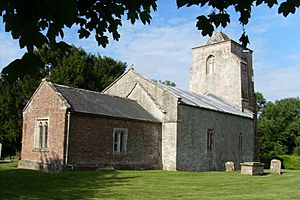All Saints Church, Alton Priors facts for kids
Quick facts for kids All Saints Church |
|
|---|---|
| Church of All Saints | |
 |
|
| Location | Alton Priors, Wiltshire, England |
| Built | 12th century |
| Website | Churches Conservation Trust |
|
Listed Building – Grade II*
|
|
| Designated | 27 May 1964 |
| Reference no. | 1364710 |
| Lua error in Module:Location_map at line 420: attempt to index field 'wikibase' (a nil value). | |
All Saints Church is a very old church located in Alton Priors, a village in Wiltshire, England. It was built way back in the 1100s! This church is so special that it's protected as a Grade II* listed building, which means it's an important historical site. Today, it's looked after by The Churches Conservation Trust, a group that helps save old churches. The church stopped being used for regular services on July 28, 1972. After that, on December 12, 1973, it was officially given to the Trust to care for.
Contents
History of the Church
The church was built using strong stones like limestone and malmstone in the 1100s. However, it has been repaired and updated many times since then. The only parts that are still from the original 12th-century building are the stone supports (called imposts) of the main arch inside. These supports have simple decorations. You can also see pieces from another 12th-century arch on display in the church.
Ancient Site Clues
There are some interesting clues that suggest this spot was special long before the church was built. Inside the church, there are trapdoors in the floor that lead to large Sarsen stones. These are the same type of stones used at famous places like Stonehenge. Also, there's a huge yew tree in the churchyard that is about 1,700 years old! These things make people think the area was a sacred place for a very long time.
Changes Over Time
In 1491, a landowner named John Button gave lead to help put a roof on part of the church. Later, in the 1700s, the main part of the church (the nave), the two-story tower at the west end, and the area around the altar (the chancel) were all rebuilt. The church has special wooden fronts for the seats that are from the Jacobean period (the early 1600s). The three bells in the tower are from the 1700s, but they are too old to be rung safely.
In 2016, some lead was stolen from the roof of the church. But the local community quickly raised money to put a temporary roof in place. The church does not have a permanent electricity supply. The churchyard, which is the land around the church, is not owned by the Churches Conservation Trust. It is looked after by the local church council and volunteers.
Important Monuments
On the north side of the chancel, there is a special tomb from the 1500s. It has a brass plate on top that remembers William Button, who died in 1591. He was the great-grandson of John Button, who helped with the roof. A famous expert named Pevsner described the monument as very imaginative. It shows William Button rising from his tomb, with the gates of heaven opening behind him and an angel appearing with a trumpet. There are also many writings on the monument.
Events at the Church
As of 2011, the church was used for three services a year. However, by 2020, there were no regular services held there. Local volunteers work hard to raise money for the church. They do this by holding a music festival every June. This festival features a music group called "Music for Awhile."
Church Parish
Alton Priors used to be a small part of a larger church area called Overton (now known as West Overton). The church in Alton Priors was about five miles by road from the main Overton church. In 1913, Alton Priors was separated from Overton. It was then joined with the nearby church area of Alton Barnes to create a new combined parish called Alton Barnes with Alton Priors. St Mary at Alton Barnes is now the main church for this parish. It is one of sixteen churches in the Vale of Pewsey group.
See also

